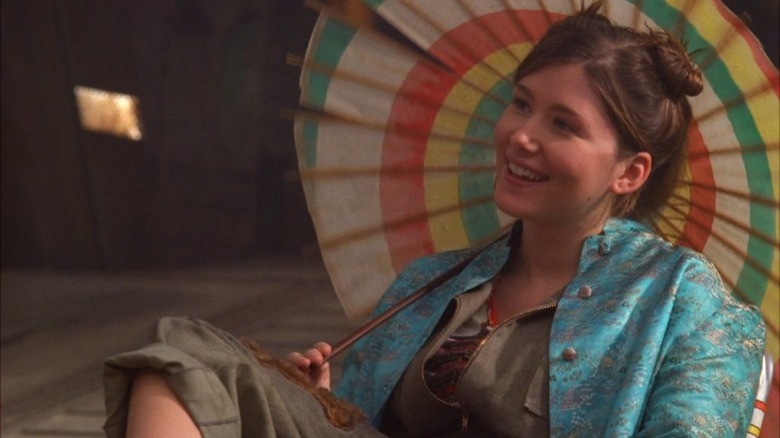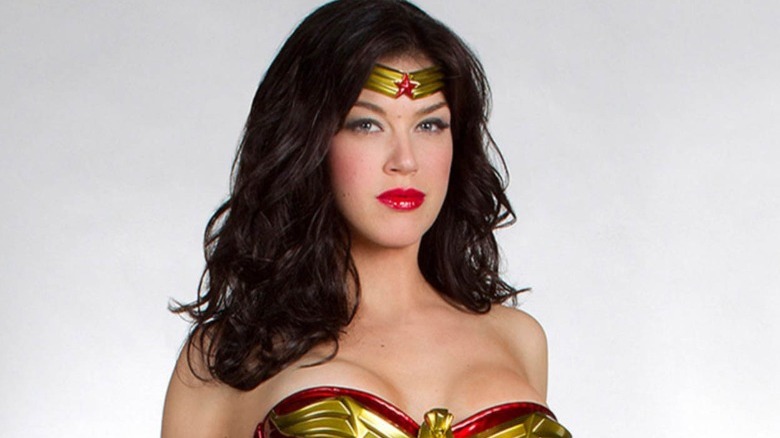
It's taken a long time, but the importance of costuming in movies and TV is finally mainstream. We've learned from legendary artists like William Ware Theiss, who was hired to design the original "Star Trek" uniforms in 1964, to modern creators like Ruth E. Carter, who brought beauty to movies for decades before winning the Academy Award for her work on "Black Panther" in 2019, that what a character looks like helps shape how we feel about them.
However, when it doesn't work, even non-fashionistas will have plenty to say. Audiences aren't always right, but they can still create essential discussions about how and why something failed. It's an even larger conversation when we're talking about science fiction because these costumes help tell us about the worlds we're exploring with a glance. And when these costumes don't work for the audience, the story can take a big hit. Slashfilm's already explored what happens when a costume failure starts a fight on the big screen. Now, we're going to take a look closer to home. Science fiction television, with its smaller budgets, often relies on costuming. Here's what can happen when a superhero suit doesn't stick the landing.
Deanna Troi's Original Star Trek Outfit Was Too Much

Deanna Troi (Marina Sirtis) got short shrift in the first seasons of "Star Trek: The Next Generation." Early series drafts show that Troi was meant to be a cerebral if exotic figure — an alien who might not have turned out as human as she ultimately did. With writers unsure how to display her empathetic gifts in those early years, and Gene Roddenberry's infamous horniness leading towards a sexier and, unfortunately, more brainless Troi, she got stuck wearing everything but a traditional Starfleet uniform.
Her original costume, not counting "Encounter at Farpoint," with its pilot weirdness, was a "casual duty" unitard that went through various shades of grey to purple to a lovely wine red. She started off with an unsightly tight beehive and bedazzled hairdo that looked more "Addams Family" than deep space explorer. "Star Trek" fans still love Troi for her insightfulness and her kindness, but they (and Sirtis herself) quietly cheered when Captain Jellico (Ronny Cox) gave her an excuse to switch to a traditional Starfleet uniform in "Chain of Command." As Sirtis complained, "...When the cleavage came... I became decorative, like a potted palm on the bridge." To us, Deanna Troi is much more than that.
Firefly Borrowed Costumes And Culture Without Representation

We still love "Firefly," and that's okay. Keep your Jayne hats and brown coats. But this too-short cult series has serious flaws that grow bigger with time. While going behind the scenes with Joss Whedon is its own messy discussion, "Firefly" also earns a place in the same breath as "Blade Runner" — and not for good reasons.
Classic dystopias and cyberpunk stories love to use a cutting-edge, neon-noir aesthetic. That often means borrowing from places like Tokyo and Hong Kong, where the future already seems to exist. "Firefly" does the same, building a world peppered with mangled Chinese language, hanzi characters used as set decoration, occasional Asian-themed fabrics and silks, and, well, the whole Companion's Guild thing, which borrows from geisha. This transformed Inara (Morena Baccarin) from what Whedon tastefully calls in "Serenity: The Official Visual Companion," a "whore," into "the most educated person on the ship, instead of just an oppressed, pathetic creature." He invokes feminism a line later, too. Anyway, despite a future inspired by a history where China won a cultural and capitalist war for Earth, there are no major Asian representatives present in "Firefly" to offer their perspectives. How exhausting.
It's What Halo's Master Chief Isn't Wearing

Have we learned nothing from Din Djarin (Pedro Pascal) and Judge Dredd (Karl Urban)? A good actor can carry a performance with body language and tone alone. New Master Chief Pablo Schreiber is a good actor, but the first season of "Halo" had him taking that helmet off all the time. Schreiber was among the first to defend 343's intention to reveal John-117's face, and his argument is a good one. Creating an emotional and visual distinction between the show's canon and the games' should've helped long-time fans know that their own Master Chiefs are untouched.
However, that wasn't enough for the audience, even with a season finale that gives John a reason to put the helmet back on and keep it on. The backlash was severe enough to spawn tons of arguments and think pieces across the web. And with enough problems with its plot to keep "Halo" fans evenly steamed, including a relationship with a prisoner of war, the helmet became a symbol of what happens when you mess with core iconography. It wasn't just about revealing the Chief's face. It was about peeling too much off of the original and replacing it with something too unsteady to stand on its own.
The Power Of The Doctor's Regenerating Wardrobe

In "Doctor Who," Time Lords are capable of physical regeneration to avoid death. Because that includes regenerating the brain, reborn Time Lords keep their memories but spawn new personalities. It's a clever way to handle actor transitions, and seeing a new Doctor wearing their last incarnation's clothes is a big deal for Whovians.
Note those details: The regeneration only affects the biological form (with the exception of the first regeneration in 1966). So why, in October 2022, did the new 14th Doctor regenerate in the 10th incarnation's clothes? Well, it was because showrunner Russel T Davies didn't want to make David Tennant dress in drag. What's more "RuPaul's Drag Race" than the 13th Doctor's (Jodie Whittaker) orange suspenders, baggy pants, striped blue shirt, and jacket? To be fair, Davies offered his reasoning for the change as an attempt to avoid "giving bigots ammo," which is a decent reason. But changing the rules of regeneration to try and silence transphobes ended up upsetting a lot of fans who see themselves in the Doctor's transitions. It's a situation with no safe solution. On the bright side, it won't be long before we formally meet Ncuti Gatwa as the 15th Doctor. Bigots and racists can choke.
Starfire's Titan(ic) Wardrobe Change

DC Comics' Starfire, real name Koriand'r, is a powerful young woman from an alien world. Despite her youth (she typically rolls with the Teen Titans), her views on romantic and sexual relationships are healthy, inclusive, and accepting. Depending on the artist and writer, of course, who sometimes forget that they're dealing with a fictional girl that other girls look up to and not their personal fetish doll.
When "Titans" hit HBO Max in 2018, some fans — excuse us, "fans" — went ballistic. We can't ignore that Starfire's actor Anna Diop underwent a deluge of harassment that did include her costume but had much more to do with fandom racism. Diop is a Senegalese woman raised in America, and her skin tone gave Starfire a refreshing vibrancy. HBO Max's Starfire has a colorful, form-fitting costume that's a far cry from the comic book's pasties, and her casual wear includes her signature purples. Racist fans derided this, accusing the "Titans" star of looking like a "hooker" in her fur coat-clad introduction — with all the cultural baggage included. Racism, sexism, and cultural stigma collide because some dudes couldn't compute a fictional character that didn't match their fantasy. This controversy only exists because some people are terrible.
Starlight Shines Too Bright Among The Boys

"The Boys" is satire. Unfortunately, some fans still need reminders. Homelander (Antony Starr) isn't a patriotic role model, A-Train (Jessie T. Usher) isn't a responsible adult, and Starlight (Erin Moriarty) is a warning about oversexualized female characters. Created by writer Garth Ennis and artist Darick Robertson, the comic series gives discussing these themes a good shot but doesn't always nail it. Its biggest crime is against Starlight, who ends up just as sexualized but with the addition of a lot of sexual abuse.
The Amazon series succeeds at improving on the original messages, if sometimes just subtly enough for fascist losers to miss the point. Starfire, however, still has to put up with a grotesquely sexualized costume for most of two seasons. It's not a costume that makes much sense without a full-on discussion about the issues here. The TV show doesn't participate in abusing Starlight, leaving it up to fans to figure out why her costume is still impractical as hell. But the biggest switch-up for Starlight (and the one fans are still debating) is her throwing the outfit into the garbage for the Season 3 finale. This is a costume "controversy" done right. Pay attention. The message is clear.
If you or anyone you know has been a victim of sexual assault, help is available. Visit the Rape, Abuse & Incest National Network website or contact RAINN's National Helpline at 1-800-656-HOPE (4673).
Star Trek Boldly Goes Where Feminism And Fashion Collide

In 1966, miniskirts weren't just fashion. They meant something to women fighting for liberation, agency, and the right to police their bodies and sexuality. Today, fans unaware of the fashion's complicated history may find it easy to look back on the outfits Nichelle Nichols and Grace Lee Whitney wore on "Star Trek" and assume a sexist mindset demanded the skimpy skirts. That's not the truth. Watching the original pilot, "The Cage," shows that everyone was going to wear the same uniform. While the networks allegedly demanded a change, the women and costumer William Ware Theiss picked up on the future's sexiest trend.
It's a historical choice that impacted Rebecca Romijin when it came time to dress the crew of "Star Trek: Strange New Worlds," and she went straight to a fashionable version of the classic mini dress, turning it into a comfortable and practical uniform anyone can wear. It further builds on an attempt to make Theiss' "Star Trek: Next Generation"-era skant a viable costuming choice. Seen occasionally in the first season and later hailed by Brad Boimler on "Lower Decks," this spandex mini dress can look good on anyone — so long as they are brave enough to cope with a bunch of jerks whining about the wokeness of it all.
The Wonder Woman Who Never Was

Can one costume sink a series before it even gets off the ground? If it's Wonder Woman's famous reds and blues, the answer is, apparently, yes. In 2011, NBC and "The Lincoln Lawyer" showrunner, David E. Kelley, were hard at work getting Diana Prince back into her invisible jet. With the statuesque actor Adrianne Palicki ("The Orville," "Agents of SHIELD") on board as the Amazonian princess, things sounded like they were going pretty smoothly.
And then the first costume promo shots dropped. Technically more demure than Lynda Carter's star-spangled shorts and bustier, this vacuum-formed latex nightmare warped Palicki's strong form into that of a Spirit Halloween model. The backlash was fast and furious, and filming a few months later revealed an upgraded suit. NBC kept the tight red bodice and golden belt from the sneak peek but changed the pants into mom jeans with golden stars down the side. Understandably, it still didn't work for preview audiences, and the "Wonder Woman" pilot went on the high shelf of some studio exec's shame closet. At least Palicki came out of it all right, and she's still many an MCU fan's favorite Mockingbird.
Bo-Katan's Mandalorian Boob Armor

Armor is meant to be protective, not decorative, no matter what your Korean MMORPG-addicted buddies say. You get hit in between the cups hard enough, and those perky 44Hs are going to explore the Far West and the Far East separately. Wear something functional. Little in "Star Wars" is as exquisitely functional as Mandalorian armor. The Armorer (Emily Swallow) is proof. When we meet her in the first episode of "The Mandalorian," her hand-forged matte bronze beskar chest piece has some geometric shape to mold to her form, but it's visually genderless.
However, Bo-Katan's (Kate Sackhoff) live-action reveal brought something extra from her time on "The Clone Wars." The Nite Owl leader and former Death Watch member had some extra curves in her beskar blues, and fans instantly took note. While the attention to detail is laudable, it's still visually out of place with her peers. Since women of note spoke up about it, Bo-Katan's armor brouhaha became a rallying cry for dozens of YouTube cheese puffs who put their yelling faces on three-hour-long video thumbnails. Google "Bo-Katan boob armor" and note the results. We're certainly not going to link to them.
The TVA Puts Loki In Cardboard-Color Khakis

As the premiere of "Loki" kicks into gear, our new variant Loki (Tom Hiddleston) undergoes processing as a prisoner of the Time Variance Authority. He loses his armor and suffers a police-style interrogation and a lifetime highlight reel that drives him to tears. It's a metaphor for being stripped down to his essentials. Thematically, it makes perfect sense. This won't be the same tough guy Loki we last saw at Thanos' feet. This one is forced to admit that his strongest illusions were cast around himself.
The rest of the season slaps him in the least stylish UPS-guy outfit a talented costume designer (Christine Wada, who used vintage 1950s fabrics) could come up with. And it's a credit to Hiddleston's unceasing charm that he still makes this thing look good. However, some fans used to Loki's hot goth fashion started to get mouthy about Loki warming up to his salaryman style. The thematic meaning went ignored, and the fact that Loki's forearms look really nice in rolled-up sleeves (sorry, Tom, we're looking respectfully) didn't stop a small but vocal cadre of fans on Twitter and Tumblr from deciding that "their" Loki died in 2013's "The Dark World." They continue to mock the new variant as a "Larry." Their loss.
Read this next: The Most Controversial Scenes In Sci-Fi Movies
The post The most controversial costumes in sci-fi TV show history appeared first on /Film.